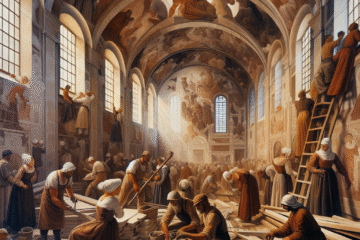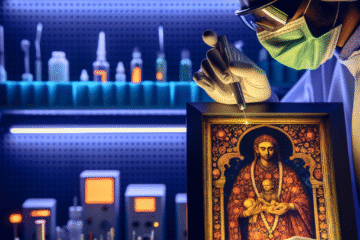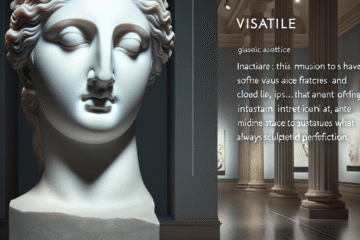I. Introduction
A. Explanation of the topic
Art has been an integral part of human civilization for centuries. From ancient times to the modern era, art has served various purposes, including religious, political, and social commentary. Politics and religion are two significant factors that have influenced art throughout history. In this article, we will explore how politics and religion have influenced art through the ages.
Artistic expression has often been used as a tool for political propaganda or as a means of reflecting political ideologies. Religion, on the other hand, has served as a significant source of inspiration for art, providing artists with subject matter, themes, and symbolism. The relationship between politics, religion, and art has been complex and multifaceted, often shaping the course of art history.
B. Brief overview of the importance of politics and religion in art history
Politics and religion have been two of the most important factors that have influenced art throughout history. The role of politics in art dates back to ancient times when rulers and leaders commissioned artists to create works that would reflect their power and authority. Political propaganda through art was particularly prevalent during the Renaissance, where rulers commissioned portraits and monumental works to assert their dominance over their subjects.
Religion has also been a crucial source of inspiration for artists. Throughout history, religious themes and symbolism have been present in art, from the ancient temples of Egypt and Greece to the paintings of the Renaissance and the sculptures of the Baroque era. Religion has been a significant influence on art, shaping its themes, style, and meaning.
C. Thesis statement
This article will explore the relationship between politics, religion, and art through history. It will examine how political ideologies and religious beliefs have influenced the art of different periods and how artists have used their works to reflect and comment on political and religious issues. Ultimately, this article will demonstrate how politics and religion have played a vital role in shaping art history and continue to influence contemporary art today.
II. The Influence of Politics on Art
Politics has been a significant influence on art throughout history. Artists have often used their works to reflect political ideologies, celebrate political leaders, or protest against political oppression. From ancient Greece and Rome to the modern era, political themes have been present in art in various forms.
A. Ancient Greece and Rome
- Explanation of political themes in ancient art
In ancient Greece and Rome, politics played a crucial role in art. Ancient Greek art, for example, was heavily influenced by the political system of the time. Athens, for example, was a democracy, and art often depicted democratic ideals. Sculptures of Greek politicians and leaders were also common, serving as a way of celebrating their achievements and glorifying their power.
Similarly, ancient Roman art often depicted political themes, particularly during the Roman Republic and Empire. Public monuments and sculptures celebrated the achievements of emperors, while propaganda art was used to promote the imperial cult and the ideals of the Roman state.
- Examples of political art from this period
One of the most famous examples of political art from ancient Greece is the Parthenon, a temple dedicated to the goddess Athena, located on the Acropolis in Athens. The Parthenon’s frieze, a sculpted band that runs around the exterior of the building, depicts the Panathenaic procession, a major festival in Athens that celebrated democracy and Athenian identity.
In ancient Rome, the Arch of Titus is a prominent example of political art. Built in Rome in 81 AD, the arch was erected to commemorate the military victories of Emperor Titus. The arch’s relief sculptures depict scenes from Titus’s campaigns, celebrating his military prowess and his success as an emperor.
B. The Renaissance
- Explanation of political themes in Renaissance art
The Renaissance was a period of great political upheaval in Europe, with the rise of powerful city-states and the emergence of powerful monarchies. Art during the Renaissance reflected these changes, with many artists creating works that celebrated political power and patronage. Many Renaissance artists were employed by wealthy families and city-states, and their works often depicted political themes or celebrated political leaders.
- Examples of political art from this period
One of the most famous examples of political art from the Renaissance is Leonardo da Vinci’s “The Last Supper.” Painted in Milan in the late 15th century, the painting depicts the final meal of Jesus Christ with his disciples. The painting has political undertones, as it was commissioned by Ludovico Sforza, the Duke of Milan, to serve as a symbol of his power and authority.
Another famous example of political art from the Renaissance is Michelangelo’s fresco on the ceiling of the Sistine Chapel in Rome. The fresco depicts scenes from the Book of Genesis, including the creation of Adam and Eve. The painting has political significance, as it was commissioned by Pope Julius II to celebrate the power and authority of the papacy.
C. 20th Century Art
- Explanation of political themes in modern art
The 20th century saw a resurgence of political art, with many artists using their works to protest against political oppression and social injustice. Political art in the 20th century was often associated with the avant-garde movements, such as cubism, surrealism, and pop art.
- Examples of political art from this period
One of the most famous examples of political art from the 20th century is Pablo Picasso’s “Guernica.” Painted in 1937, the painting depicts the bombing of the Spanish town of Guernica during the Spanish Civil War. The painting is a powerful anti-war statement, condemning the violence and suffering caused by war.
Another famous example of political art from the 20th century is the work of American artist and activist Keith Haring. Haring’s work often depicted political themes, such as nuclear disarmament, AIDS awareness, and anti-apartheid activism. His bold and colorful images were designed to reach a wide audience and communicate important social and political messages.
The Russian avant-garde artist Kazimir Malevich also created political art in the early 20th century. His work, such as his “Black Square” painting, was a rejection of traditional art and a call for a new, revolutionary art that reflected the ideals of the Bolshevik revolution.
In conclusion, politics has played a significant role in art throughout history, from ancient Greece and Rome to the modern era. Political themes have been reflected in art in various forms, from sculptures and monuments to paintings and installations. Artists have used their works to celebrate political power, protest against political oppression, and promote political and social change. The examples discussed in this article demonstrate the importance of politics in shaping art history and show how political themes have remained a vital source of inspiration for artists throughout the ages.
III. The Influence of Religion on Art
Religion has been a significant influence on art throughout history, providing artists with themes, symbolism, and subject matter. From ancient art to the Baroque era, religious themes have been present in art, reflecting the spiritual beliefs of the time and serving as a way of communicating religious ideas to a wider audience.
A. Ancient Art
- Explanation of religious themes in ancient art
Religion played a significant role in ancient art, with many works depicting gods, goddesses, and religious rituals. Ancient Egyptian art, for example, often depicted the pharaohs as gods and goddesses, and religious symbols and motifs were incorporated into many works of art.
Similarly, ancient Greek and Roman art featured religious themes, with sculptures and paintings of gods and goddesses, as well as scenes from mythological stories.
- Examples of religious art from this period
One of the most famous examples of religious art from ancient Egypt is the Great Sphinx of Giza, a massive statue of a mythical creature with the head of a human and the body of a lion. The statue is believed to have been constructed during the Old Kingdom and served as a guardian of the pyramids.
In ancient Greece, the Parthenon, a temple dedicated to the goddess Athena, was a significant religious site. The temple’s frieze depicted scenes from Greek mythology and religious rituals, serving as a way of celebrating the city’s religious and cultural identity.
B. The Middle Ages
- Explanation of religious themes in medieval art
Religion played a crucial role in medieval art, with many works depicting religious figures and scenes from the Bible. The Middle Ages saw the rise of Christianity, and religious art played a significant role in spreading the faith to the masses.
Medieval art often featured religious themes and symbolism, with paintings, sculptures, and stained glass windows depicting scenes from the Bible, saints, and religious figures.
- Examples of religious art from this period
One of the most famous examples of religious art from the Middle Ages is the Bayeux Tapestry, a monumental work of embroidery that tells the story of the Norman Conquest of England in 1066. The tapestry is significant as it depicts the battle between Harold, the last Anglo-Saxon king of England, and William the Conqueror, the Duke of Normandy. The tapestry was created to commemorate the victory of the Normans and serves as a historical and religious document.
Another famous example of religious art from the Middle Ages is the Chartres Cathedral in France. The cathedral features stunning stained glass windows that depict scenes from the Bible, including the life of Christ, the Virgin Mary, and the saints.
C. The Baroque Era
- Explanation of religious themes in Baroque art
The Baroque era saw a resurgence of religious art, with many artists creating works that reflected the spirituality of the time. Baroque art often featured dramatic scenes and emotive figures, designed to evoke strong emotions and connect the viewer with the divine.
The Baroque era also saw the rise of the Catholic Counter-Reformation, and religious art played a significant role in spreading Catholicism and countering the Protestant Reformation.
- Examples of religious art from this period
One of the most famous examples of religious art from the Baroque era is Gian Lorenzo Bernini’s sculpture, “The Ecstasy of Saint Teresa.” The sculpture depicts the moment when Saint Teresa of Avila experienced a mystical vision of an angel piercing her heart with a flaming arrow, and is designed to evoke a sense of intense emotion and spirituality.
Another famous example of Baroque religious art is the ceiling of the Sistine Chapel in Rome, painted by Michelangelo. The fresco depicts scenes from the Bible, including the creation of Adam and Eve, and serves as a testament to the power and glory of God.
In addition to painting and sculpture, the Baroque era also saw the development of religious music, with composers such as Johann Sebastian Bach and George Frideric Handel creating works that celebrated religious themes and motifs.
In conclusion, religion has played a significant role in art throughout history, providing artists with themes, symbolism, and subject matter. From ancient art to the Baroque era, religious themes have been present in art, reflecting the spiritual beliefs of the time and serving as a way of communicating religious ideas to a wider audience. The examples discussed in this article demonstrate the importance of religion in shaping art history and show how religious themes have remained a vital source of inspiration for artists throughout the ages.
IV. The Intersection of Politics and Religion in Art
The relationship between politics and religion in art has been complex and multifaceted throughout history. In some cases, politics and religion have been intertwined, with religious beliefs used to justify political power or political ideology used to enforce religious beliefs. In other cases, politics and religion have been in conflict, with art serving as a way of challenging political or religious authority.
A. The Renaissance
- Explanation of the intertwining of politics and religion in Renaissance art
The Renaissance was a period of great political and religious upheaval, with the rise of powerful city-states and the Protestant Reformation challenging the authority of the Catholic Church. Art during the Renaissance reflected these changes, with many artists creating works that reflected the intertwining of politics and religion.
Many Renaissance artists were employed by wealthy families and city-states, and their works often depicted political and religious themes or celebrated political and religious leaders. Some artists, such as Michelangelo, Leonardo da Vinci, and Raphael, were also involved in politics, serving as diplomats and advisors to powerful rulers.
- Examples of art from this period that reflects this intersection
One of the most famous examples of art from the Renaissance that reflects the intersection of politics and religion is Michelangelo’s fresco on the ceiling of the Sistine Chapel in Rome. The fresco depicts scenes from the Bible, including the creation of Adam and Eve, and was commissioned by Pope Julius II to celebrate the power and authority of the papacy.
Another example of art from the Renaissance that reflects the intersection of politics and religion is Leonardo da Vinci’s “The Last Supper.” Painted in Milan in the late 15th century, the painting depicts the final meal of Jesus Christ with his disciples. The painting has political undertones, as it was commissioned by Ludovico Sforza, the Duke of Milan, to serve as a symbol of his power and authority.
B. The 20th Century
- Explanation of the intersection of politics and religion in modern art
In the 20th century, the intersection of politics and religion in art took on new forms. The rise of totalitarian regimes and the horrors of war led many artists to use their works to challenge political and religious authority.
Many artists, particularly in the early 20th century, were also interested in exploring the spiritual and mystical dimensions of life, often incorporating religious themes and symbolism into their works.
- Examples of art from this period that reflects this intersection
One of the most famous examples of art from the 20th century that reflects the intersection of politics and religion is Salvador Dali’s painting “Christ of Saint John of the Cross.” Painted in 1951, the painting depicts the crucifixion of Jesus Christ from a unique perspective, with Christ’s body floating above the earth. The painting is an example of Dali’s interest in the spiritual and mystical dimensions of life, as well as his fascination with the Catholic Church.
Another example of art from the 20th century that reflects the intersection of politics and religion is the work of American artist and activist Keith Haring. Haring’s work often depicted political themes, such as nuclear disarmament, AIDS awareness, and anti-apartheid activism. His bold and colorful images were designed to reach a wide audience and communicate important social and political messages.
In conclusion, the intersection of politics and religion in art has been a significant theme throughout history. From the Renaissance to the 20th century, artists have used their works to reflect and challenge political and religious authority, as well as to explore the spiritual and mystical dimensions of life. The examples discussed in this article demonstrate the complexity and richness of the relationship between politics and religion in art, and show how this intersection has continued to shape and inspire artists throughout the ages.
V. Conclusion
Throughout history, politics and religion have played significant roles in shaping art, providing artists with themes, symbolism, and subject matter. From ancient Greece and Rome to the modern era, political and religious themes have been present in art, reflecting the spiritual and cultural beliefs of the time.
A. Restatement of thesis
The intersection of politics and religion in art has been a crucial theme throughout history. Artists have used their works to celebrate political power, protest against political oppression, promote political and social change, and explore spiritual and mystical dimensions of life.
B. Summary of the main points
The article has explored the influence of politics and religion on art throughout history, discussing examples from ancient Greece and Rome, the Middle Ages, the Renaissance, and the 20th century. The article has shown how political and religious themes have been present in art, reflecting the cultural and spiritual beliefs of the time, and how these themes have continued to inspire and challenge artists throughout the ages.
C. Implications of politics and religion in art for contemporary society
The intersection of politics and religion in art has implications for contemporary society, providing a lens through which to view and understand the complex relationship between politics, religion, and culture. In a world that is increasingly polarized along political and religious lines, art can serve as a bridge, connecting people across boundaries and promoting understanding and empathy.
D. Final thoughts
The relationship between politics, religion, and art is complex and multifaceted, reflecting the diversity and richness of human experience. By exploring this relationship and its historical and cultural contexts, we can gain a deeper understanding of the role that art plays in shaping our beliefs, values, and identity. As we continue to navigate the complexities of the modern world, art can serve as a powerful tool for reflection, connection, and social change.


